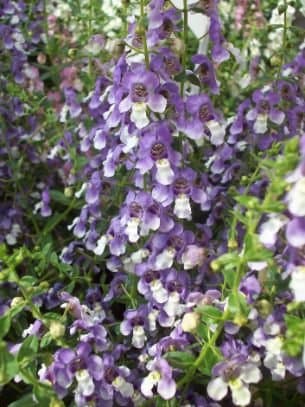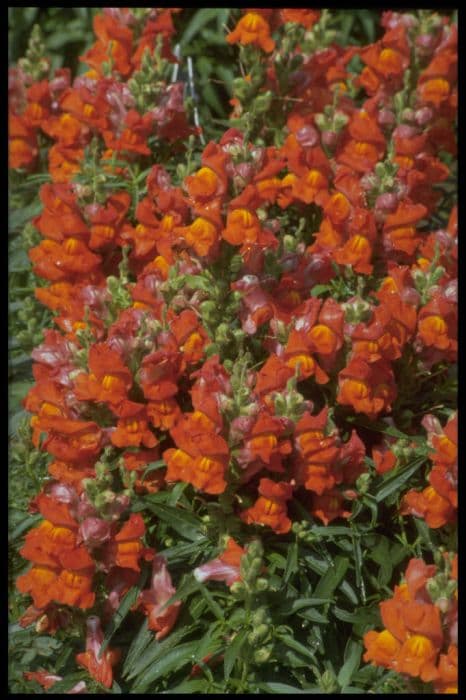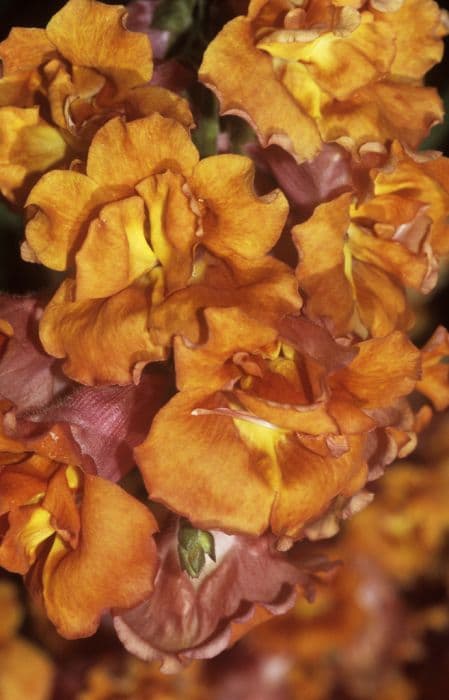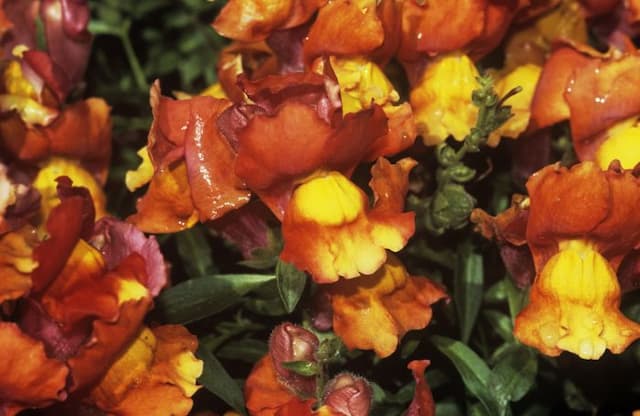Illumination Flame Foxglove Digitalis × valinii Illumination Series

ABOUT
Digitalis × valinii, commonly known from the Illumination Series, is a strikingly beautiful and ornamental plant known for its vivid and elaborate flower spikes. This hybrid boasts a lush, bushy appearance with lance-shaped leaves that are deep green, framing the plant with a dense, foliage backdrop. The leaves may have a slightly furry texture that adds to the tactile experience of the garden. The most captivating feature of this plant is its flowers. Arranged in tall, dense spikes, the blossoms are tubular in shape and come in a mesmerizing blend of colors. The color palette can range from soft peach to vibrant pink, often with beautifully speckled throats that may be a contrasting shade. This gradient effect adds depth and visual interest to the overall appearance of the plant, drawing the eye and becoming a focal point in any garden setting. These flowers have an exotic look, with the petals flaring at the mouth, giving each flower a somewhat trumpet-like appearance. This is particularly attractive to pollinators, such as bees and hummingbirds, who are drawn to the blooms for nectar. When the plant is in full bloom, the rich, saturated colors coupled with the stately spikes create a dramatic display that can last for several weeks throughout the blooming season, breathing life and color into gardens or landscapes. The overall impression is one of a robust, vibrant plant that enlivens the spaces it occupies with its resplendent blooms.
About this plant
 Names
NamesFamily
Plantaginaceae
Synonyms
Illumination Pink, Goldcrest, Flame, Raspberry, Chelsea Gold
Common names
Digitalis × valinii Illumination Series.
 Toxicity
ToxicityTo humans
The common name for Digitalis × valinii Illumination Series is foxglove. All parts of the foxglove plant are toxic to humans if ingested. It contains cardiac glycosides, which can affect the heart. Symptoms of foxglove poisoning may include nausea, vomiting, diarrhea, abdominal pain, confusion, weakness, blurred vision, changes in color vision, dizziness, and irregular heartbeats. Severe poisoning can result in cardiac arrest and potentially be life-threatening. Medical attention should be sought immediately if foxglove ingestion is suspected.
To pets
Foxglove is toxic to pets. If a pet ingests any part of a foxglove plant, they could experience symptoms similar to those in humans, which include vomiting, diarrhea, weakness, cardiac abnormalities, and potentially death. The plant's cardiac glycosides can severely affect a pet's heart function. It is critical to seek veterinary care immediately if a pet is suspected of having ingested foxglove.
 Characteristics
CharacteristicsLife cycle
Perennials
Foliage type
Evergreen
Color of leaves
Green
Flower color
Mixed
Height
2-3 feet (0.6-0.9 meters)
Spread
0.5-1 feet (0.15-0.3 meters)
Plant type
Herb
Hardiness zones
5-9
Native area
Hybrid
Benefits
 General Benefits
General Benefits- Attracts pollinators: Digitalis, commonly known as Foxglove, is known for attracting bees, butterflies, and hummingbirds to the garden, thus supporting local ecosystems.
- Ornamental beauty: The Illumination Series of Foxglove offers spectacular spikes of vividly colored tubular flowers that enhance the visual appeal of any garden.
- Long blooming period: These plants are celebrated for their lengthy blooming season, providing color and interest in the garden for an extended period.
- Shade tolerance: Foxgloves are capable of thriving in partially shaded areas, making them versatile for different garden designs and light conditions.
- Resistant to pests: Digitalis × valinii is relatively resistant to many common garden pests, reducing the need for chemical treatments.
- Vertical interest: The tall flower spikes add height and structure to garden beds and borders, creating dynamic and layered planting designs.
- Ease of care: Foxgloves are generally low-maintenance, requiring minimal care once established, which is ideal for busy gardeners.
 Medical Properties
Medical PropertiesThis plant is not used for medical purposes.
 Air-purifying Qualities
Air-purifying QualitiesThis plant is not specifically known for air purifying qualities.
 Other Uses
Other Uses- Digitalis, or foxglove, can be used as a beautiful and unique natural dye for fabrics, providing a range of greenish-brown colors.
- In small, controlled quantities, foxglove leaves can be used to create an infusion for pressurizing wood, giving it improved durability and resistance to decay.
- Foxglove flowers can be incorporated into artistic compositions and photography due to their striking appearance and variety of colors.
- The dried flowers of the foxglove plant can be used to adorn dry floral arrangements, maintaining their shape and color for long periods.
- Foxglove is used in fantasy-themed gardens to evoke a magical or mystical atmosphere because of its association with folklore and legends.
- Foxglove flowers serve as a muse for artists and designers, inspiring patterns in textiles, wallpaper, and other decorative home goods.
- The foxglove plant can be included in educational programs and botanical studies to teach about plant biology, pollination, and the ecosystem.
- With their tall and showy blooms, foxgloves can be used as a natural backdrop or privacy screen in garden landscapes.
- Foxgloves are excellent plants for theme gardens, such as a 'Cottage Garden', adding height and color diversity to garden designs.
- The plant can be used in cut flower gardens, as their long spikes and vivid blooms make striking cut flowers for vases and floral arrangements.
Interesting Facts
 Feng Shui
Feng ShuiThe Foxglove is not used in Feng Shui practice.
 Zodiac Sign Compitability
Zodiac Sign CompitabilityThe Foxglove is not used in astrology practice.
 Plant Symbolism
Plant Symbolism- Healing: Digitalis, commonly known as Foxglove, has been used medicinally to create digitalin, important for treating heart conditions. Therefore, it symbolizes healing and protection against illnesses.
- Insincerity: In Victorian flower language, Foxglove is sometimes associated with insincerity due to its poisonous nature despite its beautiful appearance, cautioning one not to be deceived by external beauty.
- Stateliness: The tall and impressive spires of Foxglove flowers symbolize stateliness and pride, fitting for a plant that commands attention in a garden.
- Magic: Historically, Foxgloves are linked to magic and folklore, often associated with fairies and woodland spirits. It's believed that the plant can invite magical beings and protect against negative influences.
 Water
WaterThe Illumination Pink foxglove should be watered deeply once a week, providing it with around 1 to 1.5 gallons of water, depending on the size of the plant and environmental conditions. During the hot summer months or in particularly dry climates, check the soil moisture frequently, as you may need to water twice a week. Reduce watering in the winter to prevent waterlogging. Always water at the base of the plant rather than overhead to avoid wetting the foliage, which can lead to fungal diseases.
 Light
LightIllumination Pink foxgloves flourish in partial shade but can tolerate full sun in cooler climates. They should be placed in a location where they receive morning sunlight and afternoon shade, especially during the hottest part of the day. Avoid deep shade, as this can lead to poor flowering and a leggy plant.
 Temperature
TemperatureFoxglove 'Illumination Pink' thrives at a temperature range between 60°F to 80°F. It can survive minimum temperatures down to 30°F but should be protected from frost. Maximum temperatures should not exceed 90°F, as extreme heat can stress the plant.
 Pruning
PruningIllumination Pink foxgloves should be pruned to remove dead or faded flowers throughout the blooming period to encourage more blooms. After the first flush of blooms, cut the flower spikes back to just above a set of leaves to stimulate a second flowering. In late autumn, after flowering has ceased, prune the plant down to the ground to keep it tidy and healthy for the next growing season.
 Cleaning
CleaningAs needed
 Soil
SoilFoxgloves from the Illumination Series prefer a well-draining, loamy soil mix with added organic matter such as leaf mold or compost. A suitable pH range is slightly acidic to neutral (pH 5.5-7.0) for optimal growth.
 Repotting
RepottingFoxglove 'Illumination Series' generally do not require frequent repotting and can be repotted every 2-3 years, or when they outgrow their current container and show signs of root crowding.
 Humidity & Misting
Humidity & MistingFoxgloves from the Illumination Series enjoy moderate humidity levels, and although they can tolerate some dryness, they perform best when the surrounding air isn't too dry.
 Suitable locations
Suitable locationsIndoor
Ensure bright, indirect light, and avoid overheating for indoor foxglove care.
Outdoor
Plant in partial shade to full sun, and protect from extreme heat for outdoor care.
Hardiness zone
8-11 USDA
 Life cycle
Life cycleThe Digitalis × valinii, commonly known as Foxglove 'Illumination', begins its life cycle as a seed, typically sown in late winter or early spring. Germination follows, emerging as seedlings with basic leaves. As they grow, the rosette of leaves develops further, and the plant enters a vegetative state. Flowering stems form as the plant matures, bearing tubular, brightly colored flowers that attract pollinators such as bees through late spring into early summer. Post pollination, the flowers develop into seed capsules, which eventually release seeds for the next generation. With the approach of winter or in harsh conditions, the plant may die back, though many varieties in the Illumination Series are perennial, allowing them to survive and regrow for several years.
 Propogation
PropogationPropogation time
Spring to Summer
Propogation: The most popular method for propagating the Foxglove Illumination Series is through basal cuttings. This process is typically done in spring or early summer when the plant is actively growing. To propagate by cuttings, select a healthy, non-flowering shoot and slice a section of the base where new growth is beginning. This cutting should include a small part of the older wood for stability. The cutting is then dipped in rooting hormone to encourage growth and planted in a pot with well-draining soil, kept moist and warm until roots develop, which can take several weeks. Once the cutting has established a root system, it can be transplanted into the garden.









